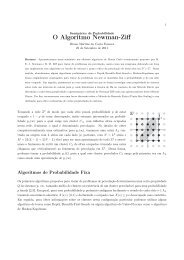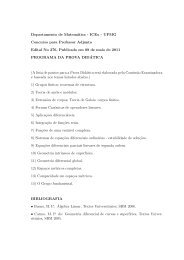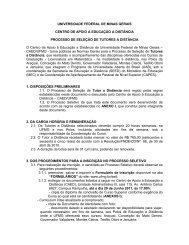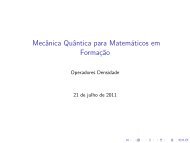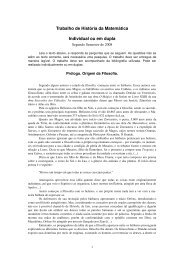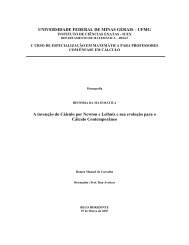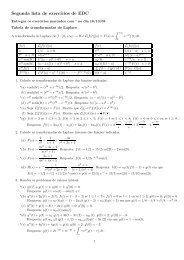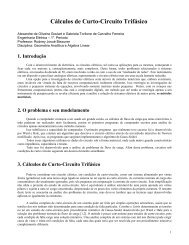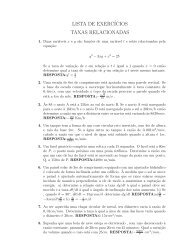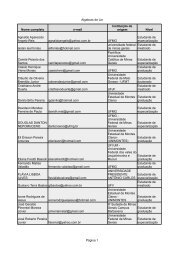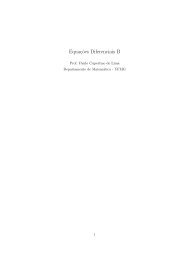Autovalores do Laplaciano - Departamento de Matemática - UFMG
Autovalores do Laplaciano - Departamento de Matemática - UFMG
Autovalores do Laplaciano - Departamento de Matemática - UFMG
Create successful ePaper yourself
Turn your PDF publications into a flip-book with our unique Google optimized e-Paper software.
Rodney Josué Biezuner 53<br />
Segue <strong>do</strong> Princípio <strong>do</strong> Máximo Discreto que a função ud − ∆dud ∞ wd assume o seu mínimo na fronteira.<br />
Este último é igual a − ∆dud ∞ max∂Ωd wd. Por sua vez, o máximo <strong>de</strong> wd na fronteira é menor ou igual ao<br />
máximo <strong>de</strong> w em ∂Ω, da<strong>do</strong> por<br />
Portanto, concluímos que<br />
para to<strong>do</strong>s i, j. Analogamente,<br />
<br />
1<br />
max x −<br />
0x1 4<br />
1<br />
2 <br />
1<br />
= max y −<br />
2 0x1 4<br />
1<br />
2 =<br />
2<br />
1<br />
8 .<br />
ui,j ui,j − ∆dud ∞ wi,j − 1<br />
8 ∆dud ∞<br />
∆d (ud + ∆dud ∞ wd) 0<br />
(2.32)<br />
e a função ud + ∆dud∞ wd assume o seu máximo na fronteira, igual a ∆dud max∂Ωd ∞ wd 1<br />
8a, <strong>do</strong>n<strong>de</strong><br />
ui,j ui,j − ∆dud ∞ wi,j 1<br />
8 ∆dud ∞<br />
para to<strong>do</strong>s i, j. Reunin<strong>do</strong> as duas <strong>de</strong>sigualda<strong>de</strong>s, segue que<br />
para to<strong>do</strong>s i, j, o que conclui a <strong>de</strong>monstração. <br />
|ui,j| 1<br />
8 ∆dud ∞<br />
2.6 Teorema. Seja Ω = (0, 1) 2 . Sejam u ∈ C 4 Ω uma solução clássica para o problema <strong>de</strong> Dirichlet<br />
−∆u = f em Ω,<br />
u = 0 sobre ∂Ω,<br />
e vd uma solução <strong>do</strong> correspon<strong>de</strong>nte problema discretiza<strong>do</strong><br />
<br />
−∆dvd = fd em Ωd,<br />
vd = 0 sobre ∂Ωd.<br />
(2.33)<br />
Então existe uma constante C > 0 in<strong>de</strong>pen<strong>de</strong>nte <strong>de</strong> u tal que<br />
ud − vd∞ C D 4 u <br />
2 2<br />
L∞ ∆x + ∆y<br />
(Ω)<br />
. (2.34)<br />
Prova. A hipótese f ∈ C2,α Ω garante que u ∈ C4 Ω . Lembre-se que<br />
<br />
D 4 u <br />
L∞ =<br />
(Ω)<br />
sup<br />
<br />
<br />
<br />
∂<br />
<br />
4u ∂xp <br />
<br />
(x, y) <br />
∂yq .<br />
Pela Fórmula <strong>de</strong> Taylor,<br />
(x,y)∈Ω<br />
p+q=4<br />
∂2u ∂x2 (xi, yj) = u(xi − ∆x, yj) − 2u(xi, yj) + u(xi + ∆x, yj)<br />
∆x2 − 2 ∂<br />
4!<br />
4u ∂x4 (xi, yj)∆x 2 − 2 ∂<br />
5!<br />
6u ∂x6 (xi, yj)∆x 4 − . . .<br />
= ui−1,j − 2ui,j + ui+1,j<br />
∆x2 − 2 ∂<br />
4!<br />
4u ∂x4 (xi, yj)∆x 2 − 2 ∂<br />
5!<br />
6u ∂x6 (xi, yj)∆x 4 − . . . ,<br />
∂2u ∂y2 (xi, yj) = u(xi, yj − ∆y) − 2u(xi, yj) + u(xi, yj + ∆y)<br />
∆y2 − 2 ∂<br />
4!<br />
4u ∂y4 (xi, yj)∆y 2 − 2 ∂<br />
5!<br />
6u ∂y6 (xi, yj)∆y 4 − . . .<br />
= ui,j−1 − 2ui,j + ui,j+1<br />
∆y2 − 2 ∂<br />
4!<br />
4u ∂y4 (xi, yj)∆y 2 − 2 ∂<br />
5!<br />
6u ∂y6 (xi, yj)∆y 4 − . . . ,




